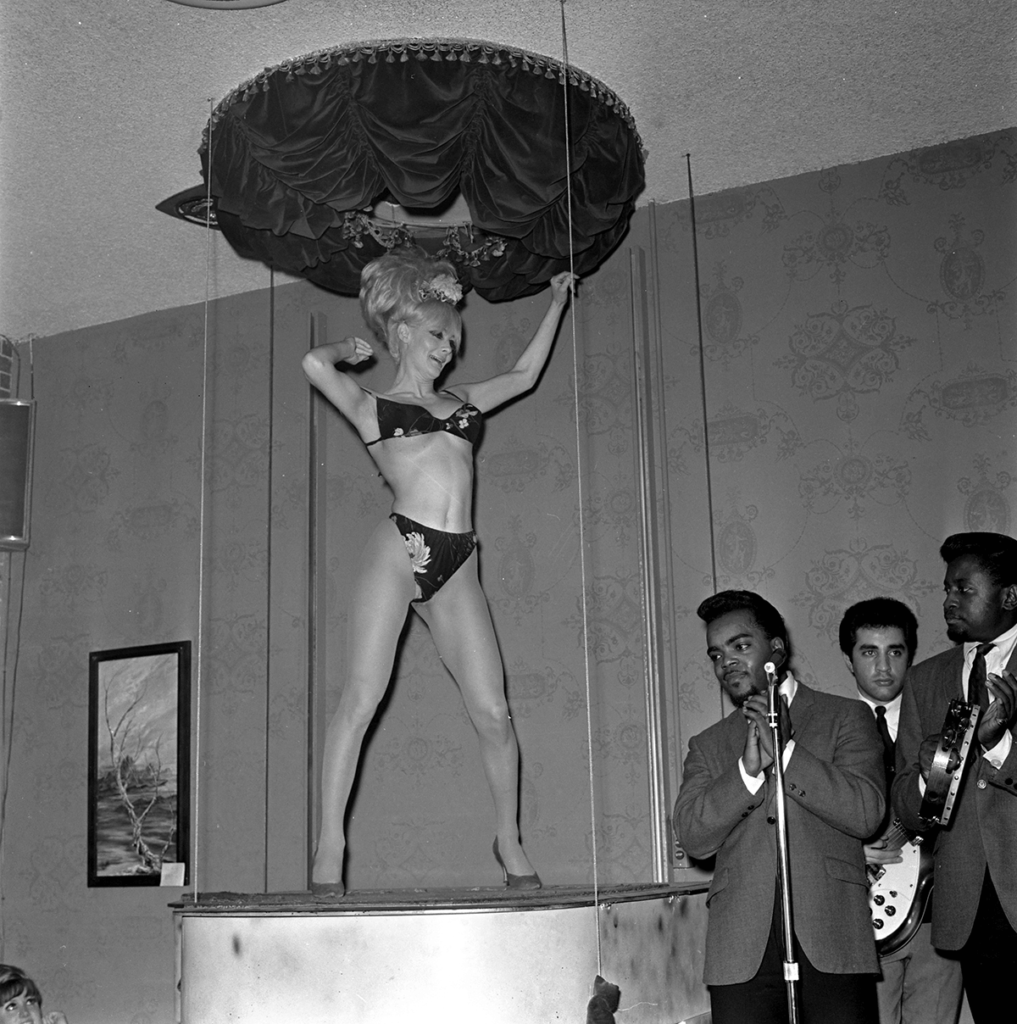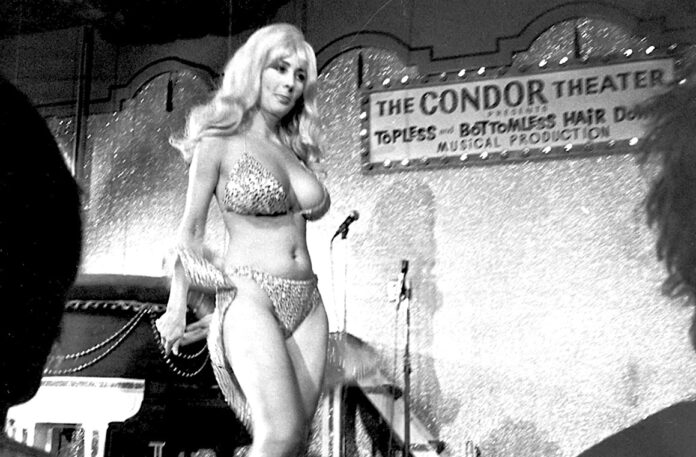There are legends who become more popular as years pass, and some whose stories hide behind a velvet curtain as newer acts dominate today’s spotlight. Occasionally, the story of a trailblazer springs back to life like a pinball machine, rattling with energy, flashing lights, and engagement. Legends don’t die—they simply keep pinging through our ambient atmosphere.
New documentary Carol Doda Topless at the Condor (see our review here) launches audiences back to North Beach’s vibrant, nocturnal rock ‘n’ roll scene. The Picturehouse film is an apt tribute to the sparkling revue that brought people from nearby neighborhoods and across the country to see the woman who sensationalized the world by dancing with her powerful humor and charisma. And oh yeah, her breasts.
Viewers will witness how discreet and disapproving America was about nudity, and how the waitress-turned-dancer shimmied and waved women closer to the sexual revolution of the 20th century. One night in 1964, a 26-year-old Doda donned a topless monokini designed by Rudi Gernreich as she danced “the Swim” on stage. She twirled around the concept of “female entertainer” as she did a pair of tassels—and eventually bared it all in the name of sexual freedom and expression.
48hills spoke with producer-directors Marlo McKenzie and Jonathan Parker via Zoom to discuss the documentary soon to dazzle audiences in movie theaters, and which opens at the Roxie Fri/22.
“This was one of those times that are really fascinating in America. It was before the sexual revolution, the Summer of Love, the Civil Rights Movement, and the Gay Rights Movement, so it’s just on the cusp of this revolutionary time,” said McKenzie. “For (Doda) to decide to do what she did was really brave and to follow something that was true to her at a time when people said, ‘This is not what women do—women don’t have a career and women don’t take off their tops.’”
The ‘60s were a decade in which people questioned authority and what society labeled as “right” and “moral.” Its discussions about control over women’s bodies, sexual freedom in the entertainment industry, and in ordinary people’s lives echo well into the present. Just last week at the Oscars, actress Florence Pugh and Brazilian pop star Anitta drew a mix of applause and disgust for their sheer dresses, as did did Doja Cat’s nipple-showing look at the Grammys earlier this year.
“The backlash that women are getting for what they’re wearing today does connect to Carol and the question of why is there always so much judgement around women’s bodies. Just let women be who they are,” said McKenzie.
Award shows are a night for actors and artists to project their personalities, style, and what they stand for as entertainers. But the red carpets continue to be a stage for censorship. Current trends of nipples only slightly blurred with sheer fabric, topless gowns that cradle the breasts, and garments crafted to give the illusion of the female reproduction organs are dividing opinions. Some people find it empowering and accepting to have control of one’s own body and image, while some get a kick out of shaming those who express sexual and creative freedom.
Help us save local journalism!
Every tax-deductible donation helps us grow to cover the issues that mean the most to our community. Become a 48 Hills Hero and support the only daily progressive news source in the Bay Area.
“The degree to which women performers reveal their bodies is still an important thing,” said Parker. “I just find that very fascinating how revealing the body continues to be a part of a performer’s artist’s work, women in particularly.”

Parker knew Doda from back when the performer had her Champaign and Lace Lingerie Boutique on Union Street about 25 years ago. His office was situated above the store’s courtyard. He wanted to learn more about her life as an entertainer, and he commented to Doda they should make a film about her. She was receptive to the idea, and later allowed him to follow her to guest appearances and performances.
Life and work often get in the way of one’s creative goals, and Parker’s hope of creating a documentary was eventually tucked inside a drawer. But McKenzie revitalized the project.
“I saw one of Jonathon’s folder of notes, and it looked kind of fun and sexy. I asked, ‘What is this, Jonathan?’,” she chuckles.
McKenzie’s curiosity was set aflame as she discovered who the busty blonde was and what Doda signified to San Francisco. She spoke with Jonathan about reopening the project, leading to six years of research and interviews with nightclub owners, North Beach dancers, bartenders, and musicians.
Despite the initial arrests of Doda and local dancers who performed bare-chested, and doubts that their performances were a “momentary gimmick,” topless entertainment became a harmless, fun act that husbands and wives could watch together, back before the clubs became a bachelor’s paradise.
Uncovered footage of interviews with Doda are warm and humorous. She comes across as kind, often joking and throwing around puns about her job and her breasts, which she later had injected with silicone to make her topless act voluptuous and competitive. It was a choice that led to risks later on in her life, as it did for other women who had the same procedure done.

McKenzie said everyone she and the team spoke with for the documentary was fond of Doda, and those who met her or knew her personally described the performer as kind. She was the girl next door, sweet and caring—a dearness that could be surprising to those familiar with her fame. “Especially, so famous in this world of nightclub entertainment, which in that scene can be kind of rough,” added Parker.
The film guides audiences through the vibrant North Beach nightlife to the dark corners of the scene, including the complications of silicone, the downfall of the artistic image of topless dancing that became darkened by drugs, gangsters, and the rise of porn and sleazy acts. The documentary transports audiences through women’s liberation, the racial tensions and disapproval of biracial marriages, including that of musician Jimi Mamou and Judy Mamou (stage name Tara), the second topless dancer in North Beach who later improved her acts with snakes and performed with “the world’s only topless monkey.”
The film gives an intimate look at the challenges Doda faced, her romantic relationships, and her life beyond topless dancing. Some people might agree that knowing too much about an artist or entertainer’s personal life changes our perception of them and their work. The film does not try to take us down a lengthy road of her life pre-show business and her domestic world, though it does acknowledge those elements.
Although McKenzie and Parker tried to set up an interview with Doda’s son, he declined to participate. Doda never wanted the spotlight to shine on her private life, but rather to focus on what she stood for, and how she revolutionized entertainment and the community. The producers of Carol Doda Topless at the Condor were happy to oblige, and wink at the (in many ways) sexually liberated future that Doda inspired.
“That’s one of the things I really love about this movie, because it brings up conversations that we are having right now,” said McKenzie. “It’s a fun, kind of sexy story that has a lot of questions in it that are echoing to today.”
CAROL DODA TOPLESS AT THE CONDOR opens Fri/22 at the Roxie with “Doda-esque Burlesque” event, then expands to wider theaters March 29. Visit CarolDodaMovie.com for locations and showtimes.







